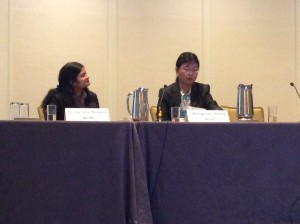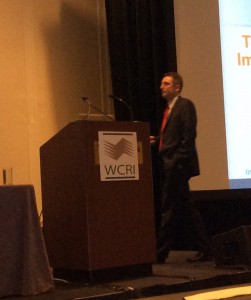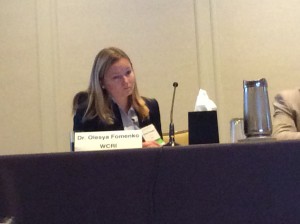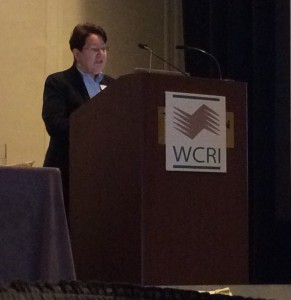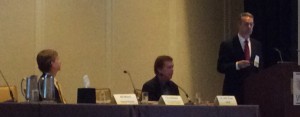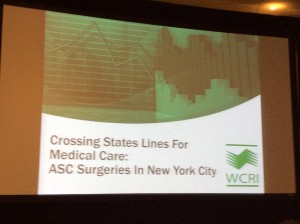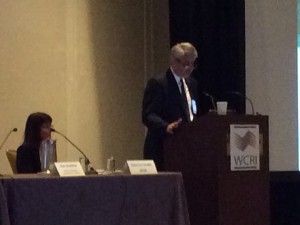The Risk Manager’s Perspective
At the 2016 Advisen Casualty Insights Conference, a panel discussed how the role of risk managers is evolving. The panel was: Stephen Kempsey – Managing Director, US Casualty Practice Leader – Marsh (moderator) Ash Kilada – Senior Director, Treasury and Risk Management – PepsiCo Inc. Ray Abromitis – Director of Risk Insurance – BlueScope Steel North America Corporation Judy McInerny – Director, Risk Management – Corning Incorporated Benjamin Gibbons – Insurance Risk Manager – SAP Question: What is one of the biggest changes you have seen since starting in risk management? Answers: The biggest change is the speed of activity.
(Read the full article…)
2016 Advisen Casualty Insights Conference
Conference Chronicles will be blogging from the 2016 Advisen Casualty Insights Conference on March 31, 2016, in New York, NY. Advisen’s Casualty Insights Conference is geared towards addressing today’s casualty risk management and insurance issues. Now in its sixth year, the conference brings together over 500 leading risk managers, brokers, underwriters, claim professionals and lawyers to share their knowledge about market trends, significant legal and regulatory developments, and emerging exposures. Learn more about the event.
Physician Dispensing and Opioid Use
At the 2016 WCRI Annual Issues & Research Conference, Dongchun Wang and Vennela Thumula from WCRI discussed physician dispensing and opioid use. The studies they discussed have not yet been published, so the results are subject to change. Physician Dispensing In the last few years, 20 states have implemented reforms targeting the pricing of physician dispensed medications. (ID, NV, CA, AZ, KS, OK, MI, IL, IN, TN, MS, AL, GA, FL, SC, NC, PA, DE, CT) In most states studied, prices paid per pill for physician-dispensed drugs decreased after the reforms. While there were fewer prescriptions dispensed by physicians, this
(Read the full article…)
Sharing Economy, Technology Advances, and Workers’ Compensation
At the 2016 WCRI Annual Issues & Research Conference, Dr Robert Hartwig from Insurance Information Institute presented a session focusing on the impact the sharing economy is having on workers’ compensation. The sharing economy is transforming the American workforce and will transform the property/casualty insurance industry across all lines. Technology provides a unique opportunity to match labor to jobs. Workers with time and skill can be paired with those seeking such services. People can use an app to find people to complete a variety of tasks. We are also seeing significant growth in temporary workers over the last 6 years.
(Read the full article…)
Why Surgical Rates Vary
At the WCRI Annual Issues & Research Conference, Dr Olesya Formenko from WCRI talked about a study into why there are variations in surgery rates for patients with back injuries. In the WCRI study, spinal surgery rates on back injury claims varied from a low of 7% in California, to a high of 19% in Oklahoma. While case mix and clinical aspects of the back injury will have an impact on surgical rates, they study looked at three areas: Local Practice Norms – By looking at group health surgery rates, they found that higher group health surgical rates was also
(Read the full article…)
State of the States (Kentucky and Georgia)
At the 2016 WCRI Annual Issues & Research Conference, a panel discussed the CompScope findings on system differences in indemnity and medical payments. CompScope is an annual benchmarking study produced by WCRI that analyzes the workers’ compensation benefits in 18 states. The focus of this presentation was information from Georgia and Kentucky. It should be noted that the study is not published yet so this information could change. The panel was: Dr Rebecca Yang, WCRI Molly Flanagan, WCRI Carol Telles, WCRI It is important to note a baseline differences between states for study purposes. Wage loss states LA, MA, MI,
(Read the full article…)
States with Decreased Medical Payments
At the 2016 WCRI Annual Issues & Research conference, Carol Tellis from WCRI discussed CompScope findings on trends in medical payments per claim from 2009-2014. From 2009-2014, half the study states had little change in medical payments per claim. 9 of the study states had increases under 3% with three states having a reduction in medical costs per claim. The focus of the rest of the presentation was the three states with reductions in medical costs (CA, IL, NC). All these states had significant policy changes that led to these cost reductions: Illinois – 2011 legislation included a 30% reduction
(Read the full article…)
Opt-Out Pros and Cons
At the 2016 WCRI Annual Issues & Research conference, a panel discussed the pros and cons of opt-out. The speakers were Trey Gillespie with PCIAA and Bill Minick from PartnerSource. It is important to distinguish between Texas and other opt-out models. In Texas, workers’ compensation is not mandatory for private employers. Employers can go completely bare with no coverage if they choose to do so. Most large employers in Texas use opt-out to replace workers’ compensation with an ERISA-style benefit plan. 95% of Texas workers are either covered by workers’ compensation or an alternative benefit plan with a small percentage
(Read the full article…)
Crossing State Lines for Medical Care
At the 2016 WCRI Annual Issues Symposium, Dr Rebecca Yang and Dr Bogdan Savych from WCRI presented the findings from a very narrow ongoing study that focused on claims from New York City that sought medical care at ambulatory surgical centers (ASC). This study was triggered by the fact they were seeing over a 30% increase in ASC payments from 2011 to 2012 with no change in fee schedule. The study only looked at claims where the worker worked and lived in New York City and had received medical care in New York City. The study found that in 2011,
(Read the full article…)
California Workers’ Compensation Medical Dispute Resolution
At the 2016 WCRI Annual Issues & Research Conference, Alex Swedlow from California Workers’ Compensation Institute (CWCI) discussed their studies around medical review and medical dispute resolution in California workers’ compensation. CWCI studies many potential areas of of friction to see the impact this had on state benefit costs. There is almost no correlation between regulatory staff per capita and costs for workers’ compensation benefit delivery. In addition, they also found little correlation between fee schedule rates and claim costs. However, they did find that attorney involvement and other issues have a significant impact on claim costs. In particular, they
(Read the full article…)



